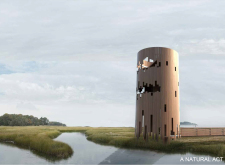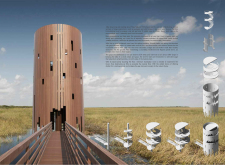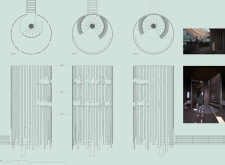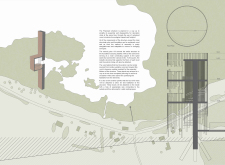5 key facts about this project
### Overview
The Natural Observation Tower is located in Pape Natural Park, designed to serve both human visitors and local wildlife within a wetland context. The cylindrical structure emphasizes ecological coexistence, positioning itself as both an observation point and a habitat for various species. This design integrates aesthetic considerations with functionality, employing a form that resonates with natural plant structures while promoting the twin goals of environmental stewardship and user engagement.
### Spatial and Structural Strategy
Central to the design is a spiral pathway that connects three observation levels, encouraging wildlife viewership while providing panoramic sightlines of the surrounding landscape. Each floor features partial openings, allowing for natural ventilation and light penetration while facilitating navigation for both people and animals. The cylindrical form minimizes ecological disruption, as the foundation is designed with a minimal footprint to preserve existing flora and fauna. Strategic placement reinforces harmony with the wetland ecosystem, ensuring the structure's longevity and viability in terms of environmental impact.
### Material and Environmental Considerations
A carefully selected palette of materials underpins the project’s sustainability ethos. Reclaimed wood forms the primary structural components, contributing to durability and reducing the demand for new resources. Metal elements provide structural support while maintaining aesthetic coherence, and glass facades enhance transparency, facilitating interaction with the natural environment. Additionally, features such as integrated faux bird nests promote wildlife habitation and education. The overall material strategy emphasizes a design that can withstand local climatic conditions while minimizing the environmental footprint, reflecting a commitment to responsible architectural practices.






















































